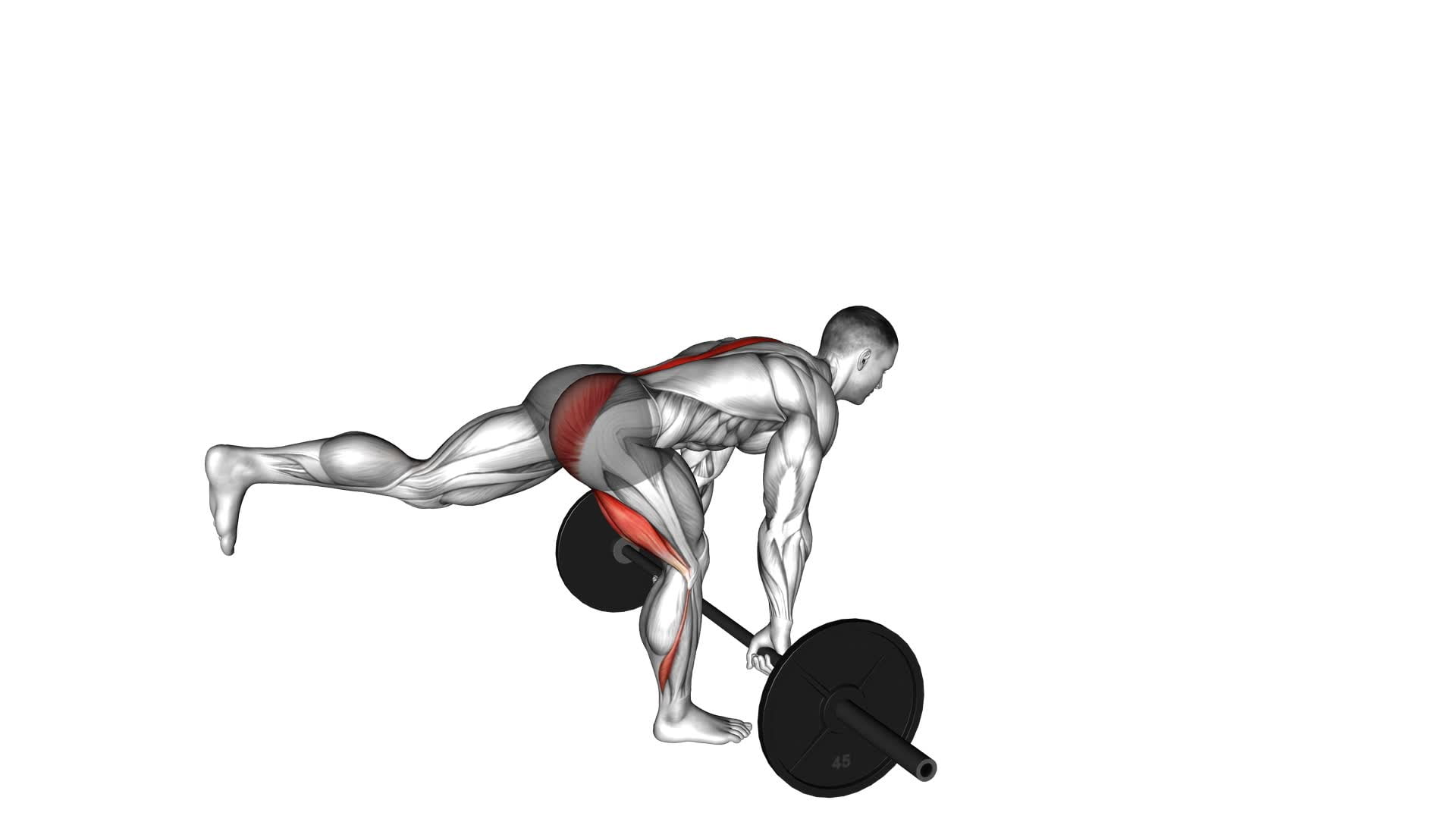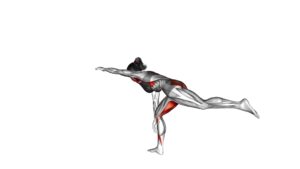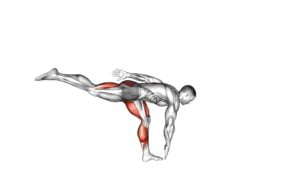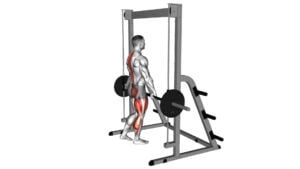Barbell Single Leg Deadlift – Video Exercise Guide & Tips

Are you looking to take your leg workouts to the next level? The barbell single leg deadlift is a challenging exercise that targets your hamstrings, glutes, and core.
Watch This Exercise Video
In this video exercise guide, you'll learn the proper form and technique, as well as helpful tips for increasing the difficulty.
With step-by-step instructions and expert advice, you'll be able to master this exercise and reap the benefits of improved strength and stability.
So grab a barbell and get ready to elevate your fitness routine.
Key Takeaways
- Proper form and technique are essential for performing the barbell single leg deadlift effectively and minimizing the risk of injury.
- Engaging the core muscles is crucial for stability and balance during the exercise.
- The barbell single leg deadlift specifically targets and strengthens the glute muscles, improving lower body strength and power.
- This exercise also challenges balance and coordination, enhancing stability and agility in everyday life.
Proper Form and Technique
To execute the Barbell Single Leg Deadlift with proper form and technique, you should hinge at the hips while keeping your back straight and engage your core for stability. This exercise isn't only effective in building strength and muscle in your glutes, hamstrings, and lower back, but it also helps in injury prevention and muscle activation.
When performing the Barbell Single Leg Deadlift, it's crucial to maintain a neutral spine throughout the movement. By hinging at the hips, you're able to target the posterior chain muscles while minimizing the stress on your lower back. Engaging your core muscles not only enhances stability but also protects your spine from excessive strain.
In terms of injury prevention, the Barbell Single Leg Deadlift is highly beneficial. By focusing on proper form and technique, you ensure that your muscles are working synergistically, reducing the risk of imbalances or compensations that can lead to injuries. Additionally, the single-leg aspect of this exercise improves balance and stability, which are essential for preventing falls and ankle sprains.
Muscle activation is another key benefit of the Barbell Single Leg Deadlift. This exercise targets the glutes, hamstrings, and lower back, activating and strengthening these muscles. By incorporating the single-leg aspect, you increase the demand on these muscles, leading to greater activation and development.
Barbell Setup and Grip
To set up for the Barbell Single Leg Deadlift, position yourself in front of the barbell with your feet hip-width apart and a comfortable grip on the bar. The grip is an important aspect of this exercise, as it helps you maintain stability and control throughout the movement. There are several barbell grip variations you can choose from based on your preference and comfort level.
The most common grip is the overhand grip, where your palms face down and your fingers wrap around the bar. This grip allows for a secure hold and evenly distributes the weight of the barbell. Alternatively, you can use an underhand grip, with your palms facing up. This grip places more emphasis on the biceps and forearms. Another option is the mixed grip, where one hand is in an overhand grip and the other hand is in an underhand grip. This grip provides additional stability and can help prevent the barbell from rolling out of your hands.
If you don't have access to a barbell, you can also use dumbbells or kettlebells as alternatives for the setup. Now that you have the proper setup and grip, let's move on to the step-by-step execution of the Barbell Single Leg Deadlift.
Step-by-Step Execution
Now, let's break down the step-by-step execution of the Barbell Single Leg Deadlift to ensure proper form and maximize the benefits of this exercise.
- Begin by standing with your feet hip-width apart, holding a barbell in front of your thighs with an overhand grip. Your palms should be facing towards your body.
- Shift your weight onto one leg while maintaining a slight bend in your knee. This will be your supporting leg throughout the exercise.
- Keeping your core engaged and your back straight, hinge forward at the hips, extending your non-supporting leg behind you. The barbell should lower towards the ground as you lower your torso.
- Continue lowering the barbell until you feel a stretch in your hamstring. Ensure that your back remains straight and your hips stay square to the ground.
- Push through your supporting leg and engage your glutes to return to the starting position. Keep the movement controlled and avoid using momentum.
Common errors to watch out for include rounding your back, allowing your knee to collapse inward, and not maintaining proper alignment between your hips, shoulders, and ankles.
Variations and modifications can be made by using dumbbells instead of a barbell, or by performing the exercise with your toes elevated on a step or block to increase the range of motion.
Common Mistakes to Avoid
Avoid these common mistakes when performing the Barbell Single Leg Deadlift to prevent injuries and maximize your workout effectiveness.
One common mistake is rounding your back during the movement. This places unnecessary strain on your spine and increases the risk of injury. To avoid this, focus on maintaining a neutral spine throughout the exercise.
Another mistake isn't engaging your core. Your core muscles play a crucial role in stabilizing your body during the movement. Be sure to brace your core and keep it tight throughout the exercise.
Additionally, avoid using excessive weight that compromises your form. Start with a lighter weight and gradually increase as your strength and technique improve.
Lastly, be aware of modifications and variations that can suit your fitness level and goals. If you're a beginner or have balance issues, you can perform the exercise with bodyweight or use a stability ball for support. On the other hand, if you're more advanced, you can try adding resistance by using dumbbells or kettlebells instead of a barbell.
Tips for Increasing Difficulty
As you progress in your Barbell Single Leg Deadlift routine, there are several strategies you can implement to increase the difficulty and challenge your muscles further. Here are four tips for increasing intensity and incorporating advanced modifications into your workout:
- Increase the weight: Once you have mastered the exercise with a certain weight, it's time to challenge yourself by adding more weight to the barbell. Gradually increase the load to push your muscles to work harder and adapt to the increased demand.
- Use unstable surfaces: Incorporating balance and stability challenges can take your Barbell Single Leg Deadlift to the next level. Try performing the exercise on a Bosu ball or a balance board to engage your core and improve your overall stability.
- Try single-arm variations: By holding the barbell with only one hand, you increase the demand on your core muscles to stabilize your body. This modification not only increases the difficulty but also enhances functional strength and coordination.
- Incorporate plyometric movements: To further increase the intensity and explosiveness of the exercise, add plyometric movements such as a jump or a hop at the top of the movement. This won't only challenge your leg muscles but also improve your power and athletic performance.
By implementing these tips, you can take your Barbell Single Leg Deadlift routine to the next level and continue challenging your muscles as you progress.
Now, let's explore the benefits of the barbell single leg deadlift.
Benefits of the Barbell Single Leg Deadlift
The Barbell Single Leg Deadlift offers several benefits that can help you improve your fitness and overall strength.
This exercise targets your core muscles and glutes, helping to strengthen and tone them.
Additionally, performing the exercise on one leg challenges your balance and stability, further enhancing your overall athleticism.
Incorporating the Barbell Single Leg Deadlift into your workout routine can provide a variety of benefits that will support your fitness goals.
Strengthening Core and Glutes
To strengthen your core and glutes, incorporate the barbell single leg deadlift into your workout routine. This exercise offers a range of benefits that will help improve your posture and prevent injuries. Here are four reasons why you should include the barbell single leg deadlift in your training:
- Core stability: The barbell single leg deadlift requires you to engage your core muscles to maintain balance and stability throughout the movement. This helps strengthen your core and improve overall stability.
- Glute activation: By performing the barbell single leg deadlift, you specifically target your glute muscles, helping to strengthen and tone them. This can enhance your overall lower body strength and power.
- Functional strength: The barbell single leg deadlift mimics movements that are often performed in daily activities, such as bending over to lift objects. By strengthening your core and glutes, you can improve your ability to perform these movements with ease and reduce the risk of injury.
- Balance and coordination: Since the barbell single leg deadlift is performed on one leg, it challenges your balance and coordination. Regularly incorporating this exercise into your routine can help improve these skills, making you more stable and agile in your everyday life.
Improving Balance and Stability
Improve your balance and stability with the barbell single leg deadlift. This compound exercise targets your core and glutes, helping to build strength. In addition, it enhances balance and stability.
When you perform the barbell single leg deadlift, you challenge your body to maintain stability on one leg while lifting a weight. This activates various muscles, including your glutes, hamstrings, and core, which are crucial for balance.
The barbell single leg deadlift is a great exercise for those looking to improve balance and stability. It not only strengthens the muscles involved but also trains your body to maintain stability during dynamic movements.
Incorporating balance exercises like the barbell single leg deadlift into your routine can improve overall stability and reduce the risk of falls or injuries.
Frequently Asked Questions
How Much Weight Should I Use When Performing the Barbell Single Leg Deadlift?
When performing the barbell single leg deadlift, it's important to consider the weight you use.
The workout intensity will depend on your goals and fitness level. Start with a weight that challenges you, but allows you to maintain proper form and technique. Gradually increase the weight as you become stronger and more comfortable with the exercise.
Remember to focus on maintaining balance and engaging your core throughout the movement.
What Muscles Does the Barbell Single Leg Deadlift Primarily Target?
The barbell single leg deadlift primarily targets several key muscles in your body. By performing this exercise, you can benefit your glutes, hamstrings, and lower back.
It's important to maintain proper form for the barbell single leg deadlift to maximize its effectiveness. Make sure to keep your back straight, core engaged, and focus on balancing on one leg while lowering the barbell.
This exercise can help improve your balance, stability, and overall lower body strength.
Can the Barbell Single Leg Deadlift Be Modified for Individuals With Limited Flexibility or Mobility?
If you have limited flexibility or mobility, there are modified techniques and alternative exercises available for the barbell single leg deadlift. These modifications can help accommodate your specific needs and still allow you to work on strengthening your lower body.
How Often Should I Incorporate the Barbell Single Leg Deadlift Into My Workout Routine?
To get the most out of the barbell single leg deadlift, it's important to incorporate it into your workout routine regularly. This exercise offers numerous benefits, such as improving balance, strengthening your core, and targeting your hamstrings and glutes.
To perform it properly, stand with your feet hip-width apart, hold the barbell with an overhand grip, and lift one leg off the ground while hinging forward at the hips. Remember to maintain a straight back and engage your core throughout the movement.
Are There Any Variations or Progressions of the Barbell Single Leg Deadlift That I Can Try Once I Have Mastered the Basic Movement?
Once you have mastered the basic movement of the barbell single leg deadlift, there are several variations and progressions you can try to challenge yourself further.
One option is to add weight to the exercise by using a heavier barbell or dumbbells.
Another variation is the single leg deadlift with a kettlebell, which requires more stability and control.
Additionally, you can try performing the exercise on an unstable surface like a balance board or Bosu ball to further engage your core muscles.
Conclusion
In conclusion, the barbell single leg deadlift is a challenging exercise that targets multiple muscle groups, including the glutes, hamstrings, and core.
By maintaining proper form and technique, utilizing the correct barbell setup and grip, and following the step-by-step execution, you can maximize the benefits of this exercise.
Avoiding common mistakes and gradually increasing the difficulty level will help you achieve better results.
Incorporate the barbell single leg deadlift into your workout routine to improve strength, stability, and balance.

Author
Years ago, the spark of my life’s passion ignited in my mind the moment I stepped into the local gym for the first time. The inaugural bead of perspiration, the initial endeavor, the very first surge of endorphins, and a sense of pride that washed over me post-workout marked the beginning of my deep-seated interest in strength sports, fitness, and sports nutrition. This very curiosity blossomed rapidly into a profound fascination, propelling me to earn a Master’s degree in Physical Education from the Academy of Physical Education in Krakow, followed by a Sports Manager diploma from the Jagiellonian University. My journey of growth led me to gain more specialized qualifications, such as being a certified personal trainer with a focus on sports dietetics, a lifeguard, and an instructor for wellness and corrective gymnastics. Theoretical knowledge paired seamlessly with practical experience, reinforcing my belief that the transformation of individuals under my guidance was also a reflection of my personal growth. This belief holds true even today. Each day, I strive to push the boundaries and explore new realms. These realms gently elevate me to greater heights. The unique combination of passion for my field and the continuous quest for growth fuels my drive to break new ground.







